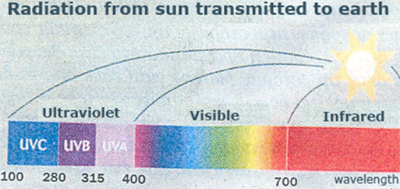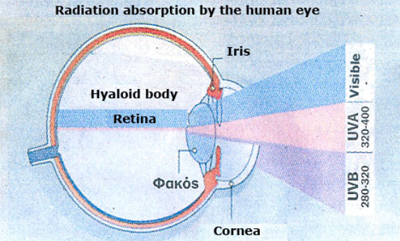The light-giver sun, an enemy for our eyes
In Ancient Greek mythology, Daedalus and Icarus were killed in their effort to reach to the Sun as close as possible. Life-giver Sun, which makes living in Earth possible, sends along with light rays other rays that are disastrous for our eyes.
Written by
Zisis Bisogiannis
Ophthalmologist, Scientific Collaborator, Head of the Ophthalmology Department of MITERA General Clinic
In ancient times, Socrates advised Athenians not to look at the sun even in eclipses, but to observe its reflection on the water. And he was completely right; because looking at the sun during the sun eclipse causes a destructive burn to the human eye fovea, the central and most important part of the retina, leading to irreversible damage to their sight.
In the 19th century, scientists noted that apart from the rays consisting visible light, there are other rays that human eyes cannot see. They are at both ends of the visible spectrum.
Especially dangerous are the ones with short wavelengths on the left side of the “rainbow”. And we refer to rainbow, this amazing celestial phenomenon, because it is nothing more than the resolution of the visible spectrum into the colours it consists of.
Each of these colours has a wavelength, with violet having the shortest one. Below the violet colour there are the UV-Ultraviolet rays that are harmful for our eyes. We should underline that among Ultraviolet rays the most dangerous for humans are the UVC rays, but luckily the ozone layer in the stratosphere manages to absorb the greatest part of them.
Every time the ozone layer gets thinner it has a direct consequence to our health.
It has been estimated that every time the ozone layer gets thinner by 1%, there is an increase in cataract cases by 0.5%, a percentage that corresponds to 100,000 – 150,000 cases of cataract worldwide. A very interesting information came to light some years ago, when the discussion over the “ozone hole”, i.e. the depletion of the ozone layer, took great dimensions; according to this information many cases of cataract were observed in the lovely penguins of Antarctica.
This fact made of course quite an impression and furthermore it also caused the ecological organizations to condemn the use of various chemical substances that contribute to the depletion of the ozone layer.
Since then a reduction in the use of these substances has been made without of course achieving, as we know, the complete reconstitution of the ozone layer. UVA radiation affects mainly the retina causing lesions in the eye fovea, which as we mentioned before is the central point of our sight. UVA rays achieve to reach the retina like the ones of the visible spectrum, which help us to see the world. UVB Ultraviolet rays reach only the cornea causing keratitis (punctuate, recurrent etc) due to their phototoxicity. A typical example is the one of skiers, who neglect to put on their protective glasses and they suffer from various forms of keratitis and even from herpes on the cornea.
Due to all aforementioned, it is necessary to protect our eyes against these harmful rays and this can be achieved, of course, with the use of the appropriate sun glasses.
As far as dark glasses are concerned, it is known that Chinese judges wore them for the first time at about 1300 BC to avoid showing their feelings when they faced witnesses and defendants during trials. But if it weren’t for celebrities who wanted to protect their faces from the photographers, dark glasses would have never become a product of public consumption.
It took many years for us to understand that dark glasses are necessary for health reasons as well. In 1988 American Ophthalmologists, in a survey carried out on 800 fishermen in Chesapeake Bay, came to the conclusion that those of them who have not been using hats with wide brim and protective glasses suffer from various forms of cataract.
Ophthalmogy has made provisions for it and using Technology not only high absorbance sun glasses have been manufactured but also contact and intraocular lenses with sufficient absorbance, which are used in replacement of the cataractous physiological lens in cataract surgeries (UV protection).
UVA and UVB ultraviolet rays are the most silent, implacable and insidious enemy. They affect children and adults lying on the beach, skiing or trying to get a suntan in solariums, working at the beach or at the sea, performing welding, working on calcinated glass or just staring for a while at the fire in the fireplace.
The advices any Ophthalmologist gives regarding the protection of our eyes from these ultraviolet and dangerous rays can be summarized to the following:
- Parents should have their children’s eyes protected with adequate sun glasses from the age of 6 months.
- If parents wear frequently their dark glasses, there are more chances that their little ones wear their own, as they usually want to do what elder ones do.
- Ultraviolet radiation affects the eyes even during cloudy summer days.
- A hat with a wide brim can reduce harmful ultraviolet radiation that reaches the eyes up to 50%.
- The size of sun glasses should be the biggest possible to be effective.
UV radiation acts in accumulative manner to our body and after time its consequences will come up where least expected (skin, eyes). Even those wearing contact lenses with protective coating for ultraviolet radiation need sun glasses.
Furthermore, it is necessary even for those subjected to correction of myopia, hyperopia or astigmatism with the up-to-date Excimer Laser method to wear sun glasses.
Those who have been subjected to operation for cataract or for the replacement of their physiological lens (Refractive surgery), in spite of these intraocular lenses providing protection against ultraviolet radiation, should wear proper protective sun glasses as well.


In Ancient Greek mythology, Daedalus and Icarus were killed in their effort to reach to the Sun as close as possible.


